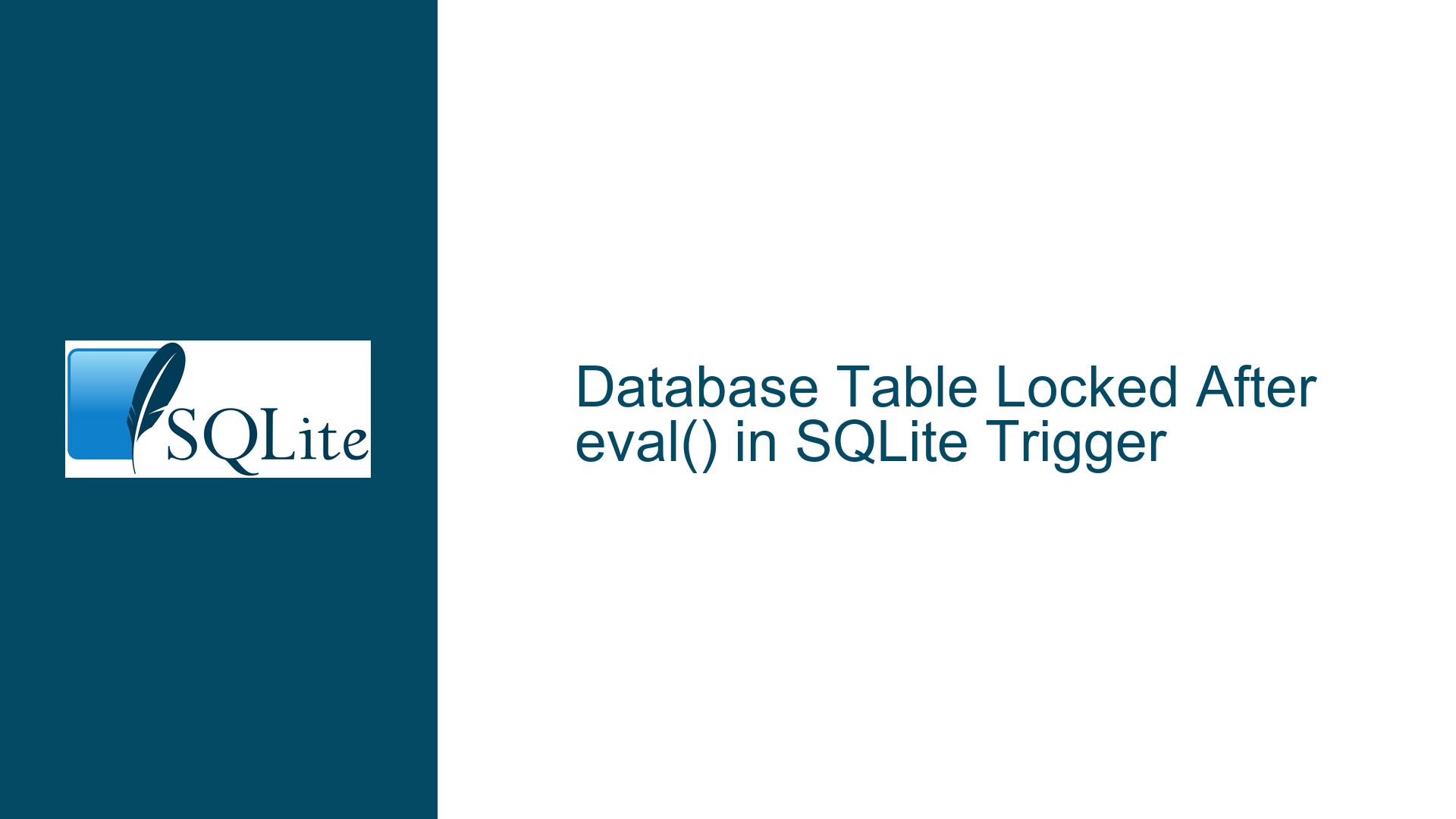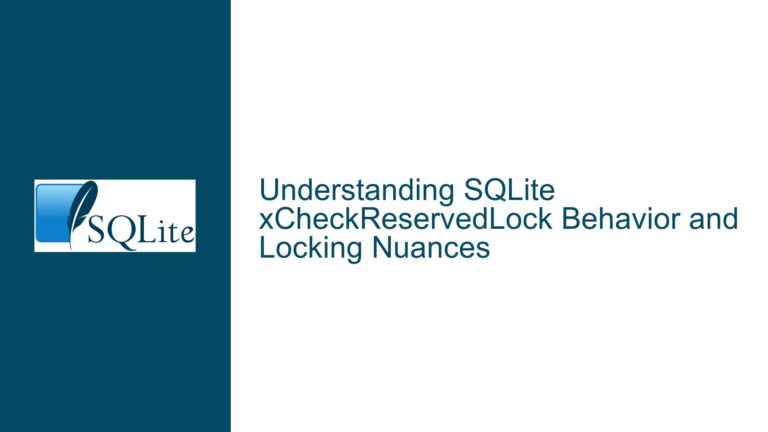Database Table Locked After eval() in SQLite Trigger
SQLite Trigger and eval() Interaction Causing Table Lock
The core issue revolves around the interaction between SQLite’s eval() function and triggers, specifically when eval() is used within a trigger to dynamically create and modify tables. The problem manifests as a "database table is locked" runtime error, even though no other processes or connections are accessing the database. This error occurs after inserting a new row into the backlog table, which fires a trigger that uses eval() to drop, recreate, and repopulate a dynamically generated table named PV_BACKLOG.
The eval() function is a powerful tool in SQLite, allowing the execution of dynamically constructed SQL statements. However, its use within triggers introduces complexities due to SQLite’s transaction and locking mechanisms. When eval() is called within a trigger, it executes SQL statements in the same transaction context as the trigger itself. This can lead to situations where the database engine perceives a lock conflict, even though no explicit locks are held by external processes.
The issue becomes apparent when the trigger attempts to drop and recreate the PV_BACKLOG table while inserting new rows into the backlog table. The error suggests that the table is locked, but the ability to manually drop the PV_BACKLOG table indicates that the lock is not a traditional database lock. Instead, it is likely a side effect of the transaction management and the way eval() interacts with the database engine within the trigger context.
Transaction Management and Locking Behavior in eval()-Driven Triggers
The root cause of the "database table is locked" error lies in the interplay between SQLite’s transaction management and the use of eval() within triggers. SQLite employs a locking mechanism to ensure data integrity during concurrent operations. When a trigger is fired, it operates within the same transaction as the statement that invoked it. This means that any operations performed by the trigger, including those executed via eval(), are part of the same transaction.
When eval() is used to drop and recreate a table within a trigger, SQLite’s transaction management system may interpret these operations as conflicting with the ongoing insert operation. The database engine attempts to acquire locks on the PV_BACKLOG table to ensure consistency, but the nested nature of the operations within the trigger can lead to a deadlock-like situation. This is not a traditional deadlock but rather a scenario where the transaction management system cannot proceed due to perceived conflicts.
Additionally, the dynamic nature of the eval() function complicates the locking behavior. Since eval() constructs and executes SQL statements at runtime, the database engine must handle these statements within the existing transaction context. This can lead to situations where the engine cannot accurately determine the locking requirements, resulting in the "database table is locked" error.
Another contributing factor is the way SQLite handles schema modifications within transactions. When a table is dropped and recreated, SQLite must update the internal schema representation. This process can conflict with ongoing operations, especially when performed within a trigger. The combination of schema modifications and data insertions within the same transaction creates a complex locking scenario that the database engine struggles to resolve.
Resolving Lock Conflicts and Optimizing eval() Usage in Triggers
To address the "database table is locked" error and optimize the use of eval() within triggers, several strategies can be employed. These solutions focus on modifying the trigger logic, adjusting transaction management, and leveraging SQLite’s features to avoid locking conflicts.
1. Separating Schema Modifications from Data Operations:
One effective approach is to separate schema modifications (such as dropping and recreating tables) from data operations (such as inserting rows). This can be achieved by restructuring the trigger logic to perform schema modifications outside of the trigger context. For example, a separate mechanism can be used to handle the creation and modification of the PV_BACKLOG table, ensuring that these operations do not interfere with the insert operations on the backlog table.
2. Using Temporary Tables:
Instead of dynamically creating and dropping the PV_BACKLOG table, consider using a temporary table. Temporary tables are session-specific and are automatically dropped when the database connection is closed. This approach eliminates the need for frequent schema modifications and reduces the likelihood of locking conflicts. The trigger can then focus on populating the temporary table with the required data.
3. Implementing Deferred Transactions:
SQLite supports deferred transactions, which delay the acquisition of locks until necessary. By using deferred transactions, the trigger can perform its operations without immediately acquiring locks on the PV_BACKLOG table. This can help reduce the likelihood of locking conflicts, especially when multiple operations are performed within the same transaction.
4. Leveraging SQLite’s PRAGMA Commands:
SQLite provides several PRAGMA commands that can influence locking behavior and transaction management. For example, setting PRAGMA journal_mode to WAL (Write-Ahead Logging) can improve concurrency and reduce locking conflicts. Additionally, PRAGMA locking_mode can be adjusted to control how SQLite acquires locks. Experimenting with these settings can help mitigate the locking issues observed in the trigger.
5. Refactoring the Trigger Logic:
In some cases, refactoring the trigger logic to minimize the use of eval() can resolve locking conflicts. Instead of dynamically constructing and executing SQL statements, consider using static SQL statements with parameterized inputs. This approach reduces the complexity of the trigger and allows the database engine to better manage transactions and locks.
6. Implementing Error Handling and Retry Logic:
To handle transient locking issues, implement error handling and retry logic within the application code. When a "database table is locked" error occurs, the application can wait for a short period and retry the operation. This approach can help mitigate the impact of locking conflicts, especially in high-concurrency environments.
7. Monitoring and Analyzing Locking Behavior:
Use SQLite’s diagnostic tools to monitor and analyze locking behavior. The sqlite3_status function provides insights into the database engine’s internal state, including lock usage and transaction management. By understanding the locking behavior, you can identify potential bottlenecks and optimize the trigger logic accordingly.
By implementing these strategies, you can resolve the "database table is locked" error and optimize the use of eval() within triggers. These solutions focus on improving transaction management, reducing locking conflicts, and leveraging SQLite’s features to ensure smooth and efficient database operations.






